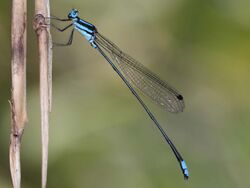Biology:Esme mudiensis
| Esme mudiensis | |
|---|---|

| |
| male | |
| Scientific classification | |
| Domain: | Eukaryota |
| Kingdom: | Animalia |
| Phylum: | Arthropoda |
| Class: | Insecta |
| Order: | Odonata |
| Suborder: | Zygoptera |
| Family: | Platycnemididae |
| Subfamily: | Disparoneurinae |
| Genus: | Esme |
| Species: | E. mudiensis
|
| Binomial name | |
| Esme mudiensis Fraser, 1931
| |
Esme mudiensis[2][1] is a damselfly in the family Platycnemididae. It is commonly known as the Travancore bambootail.[3] It is endemic to the Western Ghats in India , particularly south of Palakkad Gap.[1][4]
Description and habitat
It is a medium-sized damselfly with black-capped blue eyes. Its thorax is velvet-black on the dorsum and azure blue on the sides. The dorsum is marked with narrow ante-humeral blue stripes, and there is another moderately broad black stripe over the postero-lateral suture. The base of the sides is pale blue. Wings are transparent with black and diamond shaped pterostigma. The abdomen is black, marked with azure blue on segment 1 and 2. Segments 3 to 6 have very narrow baso-dorsal annules. Segments 8 to 10 are blue. There is a narrow black basal annule on segment 8. The ventral borders of all segments are broadly black. Anal appendages are black. The female is similar to the male, but with a more robust build.[5]
It can be easily distinguished from other species of Esme by the labrum being entirely unmarked with metallic blue-black.[5]
It is usually found along hill streams, and seen perched on riparian vegetation.[5][6][7][3][8]
See also
- List of odonates of India
- List of odonata of Kerala
References
- ↑ 1.0 1.1 1.2 Kakkasery, F. (2011). "Esme mudiensis". IUCN Red List of Threatened Species 2011: e.T175170A7116857. doi:10.2305/IUCN.UK.2011-1.RLTS.T175170A7116857.en. https://www.iucnredlist.org/species/175170/7116857. Retrieved 20 November 2021.
- ↑ "World Odonata List". University of Puget Sound. https://www.pugetsound.edu/academics/academic-resources/slater-museum/biodiversity-resources/dragonflies/world-odonata-list2/.
- ↑ 3.0 3.1 "Esme mudiensis Fraser, 1931". India Biodiversity Portal. http://indiabiodiversity.org/species/show/227134.
- ↑ K.A., Subramanian; K.G., Emiliyamma; R., Babu; C., Radhakrishnan; S.S., Talmale (2018). Atlas of Odonata (Insecta) of the Western Ghats, India. Zoological Survey of India. pp. 116–117. ISBN 9788181714954.
- ↑ 5.0 5.1 5.2 C FC Lt. Fraser (1933). The Fauna of British India, including Ceylon and Burma, Odonata Vol. I. Red Lion Court, Fleet Street, London: Taylor and Francis. pp. 264-266. https://archive.org/details/FraserOdonata1.
- ↑ C FC Lt. Fraser (1931). Additions to the Survey of the Odonate (Dragonfly) Fauna of Western India, with Descriptions of Nine New Species. pp. 472–473. http://faunaofindia.nic.in/PDFVolumes/records/033/04/0443-0474.pdf.
- ↑ Subramanian, K. A. (2005). Dragonflies and Damselflies of Peninsular India - A Field Guide. http://www.ias.ac.in/Publications/Overview/Dragonflies.
- ↑ "Esme mudiensis Fraser, 1931". Odonata of India, v. 1.00. Indian Foundation for Butterflies. http://www.indianodonata.org/sp/326/Esme-mudiensis.
External links
Wikidata ☰ Q2450884 entry
 |


